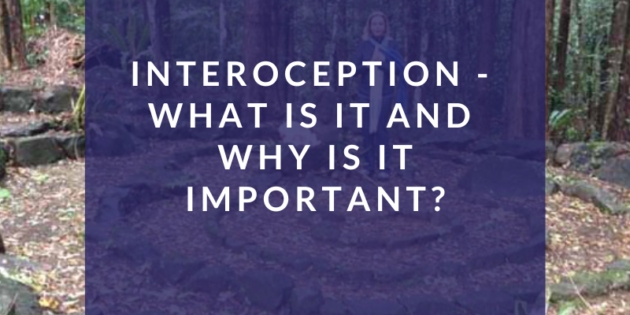One thing I have learnt from my own experiences over the years is how resourceful and resilient the human body is. It is also shares insights with us, however sometimes we are not listening. When I was learning mindfulness, I came across the concept of interoceptive awareness. Before, we look at what interoceptive awareness is, let’s look at interoception.
What is Interoception?
A few of the definitions of interoception include –
- “is contemporarily defined as the sense of the internal state of the body. This can be both conscious and non-conscious. It encompasses the brain’s process of integrating signals relayed from the body into specific subregions – like the brainstem, thalamus, insula, somatosensory, and anterior cingulate cortex – allowing for a nuanced representation of the physiological state of the body. ~ Wikipedia
- “Interoception is a sense that provides information about the internal condition of our body – how our body is feeling on the inside. Interoception allows us to experience many body sensations such as a growling stomach, dry mouth, tense muscles or racing heart.” ~ Kelly Mahler
- The word “interoception” was coined by British neurophysiologist Charles Sherrington “to refer to sensations from the interior of the body, especially the viscera.” ~ Craig, 2015
- Craig (2015) discovered from his research that interoception included “small-diameter sensory input from the whole-body – not only from viscera, muscle, joints and teeth, but also from skin. This concept of interoception includes the idea of common sensation. And in this conceptual framework, nocioception and thermoreception are aspects of interoception.” (p.4).
A cool look at the inner workings of the human body follows –
What is Interoceptive Awareness?
Now we are on the same page for interoception, let’s look at what interoceptive awareness is –
- Craig (2015) indicated “Bodily awareness has been called interoceptive awareness by investigators interested in the effects of cardiorespiratory or visceral sensory activity on human mood, emotion, and performance. The feeling of heartbeat awareness is often used as a measure of the capacity for individuals interoceptive awareness.” (p.5)
- Tribole and Resch (2012) state that interoceptive awareness is “…a process in which your brian receives physical sensations within your body, such as fast heartbeat, heavy breathing, hunger and fullness. Interoceptive awareness also includes the physical sensations triggered by emotions.” (p.283).
- “…refers to the conscious perception of sensations from inside the body that create the sense of the physiological condition of the body, such as heart beat, respiration, satiety, and the autonomic nervous system sensations related to emotions.” ~ Mehling et al 2012.
Why is Interoceptive Awareness Important?
Interoceptive awareness is important for many reasons. A few of them include –
- Van Der Kolk (2015) – “Neuroscience research shows that the only way we can change the way we feel is by becoming aware of our inner experience and learning to befriend what is going on inside ourselves.” (p.206).
- Knowing when you are hungry or full from eating.
- Being aware of how your body is moving and feeling, so you can meet it’s needs (for example – put a jacket on when you are feeling cold).
- Tribole and Resch (2017) – “…is the direct experience of your physical body. Being attuned to these sensations give you powerful information into your physical and psychological state, which can help you determine what you need to do in order to meet its needs.” (p.35).
- Craig (2015) ~ “Better heart rate perceivers [which is a measure of interoceptive awareness] are better at reading their own emotional feelings, and subjects who are better at reading their own feelings are better at reading others’ emotional feelings.” p.6).
Over to You…
I hope this post has given you some insight in to interoceptive awareness and why it is important. Remember – we can increase our interoceptive awareness with practise and training. Feel free to share any questions or comments, please leave them below.
If you are ready to reclaim your courage and take the next step towards your freedom and opening your heart, why not join our Toolkit? Also – you are invited to download the free 10-minute mindful eating exercise here.
References –
Craig, A. D. (2009). How do you feel – now? The anterior insula and human awareness. Nature Reviews Neuroscience, 10(1), 59-70.
Craig, A.D. (2015). How Do You Feel? An Interoceptive Moment with Your Neurobiological Self. New York, USA: Princeton University Press.
Mehling, W.E., Price, C., Daubenmier, J.J., Acree, M., Bartmess, E. & Steward, A.(2012). The Multidimensional assessment of interoceptive awareness (MAIA). PLoS One 7:e.48230. doi:10.1371/journal.pone.0048230
Tribole, E., & Resch, E. (2012). Intuitive Eating – A Revolutionary Program that Works. New York, USA: St. Martin’s Griffin.
Tribole, E., & Resch, E. (2017). The Intuitive Eating Workbook: 10 Principles for Nourishing a Healthy Relationship With Food. California, USA: New Harbinger Publications Inc.
Van Der Kolk, B. (2015). The Body Keeps the Score. Mind, Brain and Body in the Transformation of Trauma. USA: Penguin Books.

















2 Comments
[…] in each posture, we are choosing self-love over ego. In a loving yoga practice, we strengthen our interoceptive awareness – our ability to detect the subtleties of our internal landscape. Moving mindfully on our mat […]
[…] eating is a lifelong practice that focuses heavily on body awareness, so that we can honor both our biological and psychological needs by listening and responding to the […]
Leave A Response